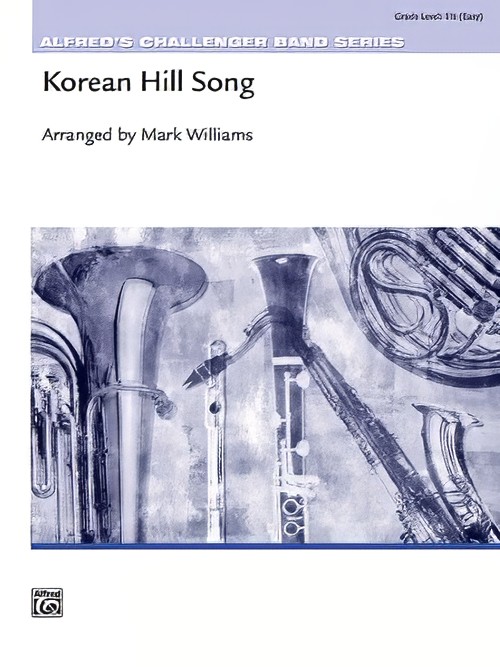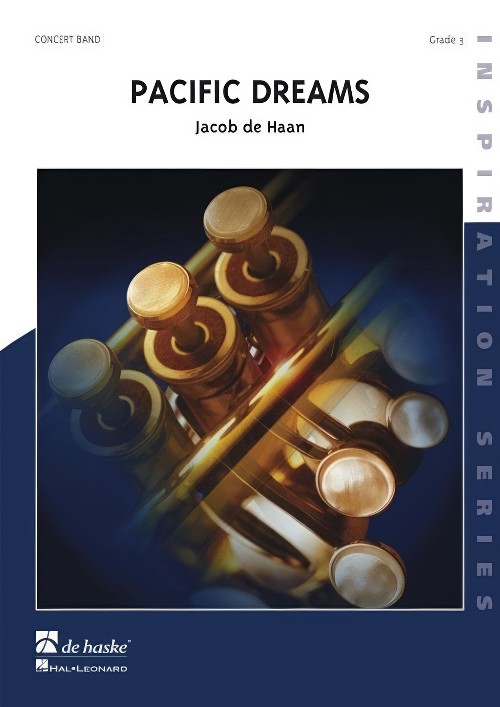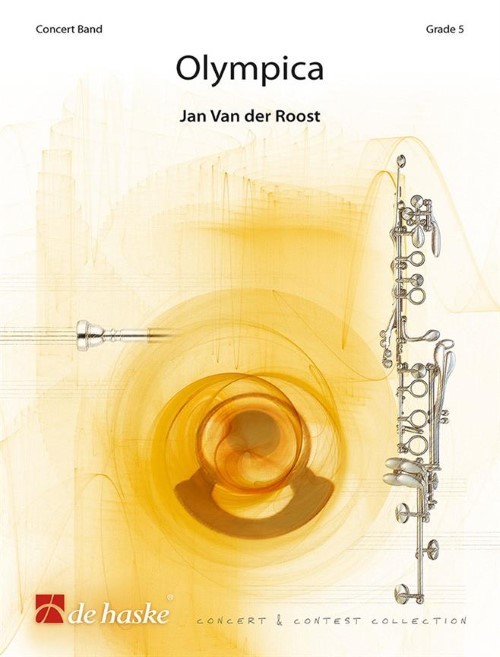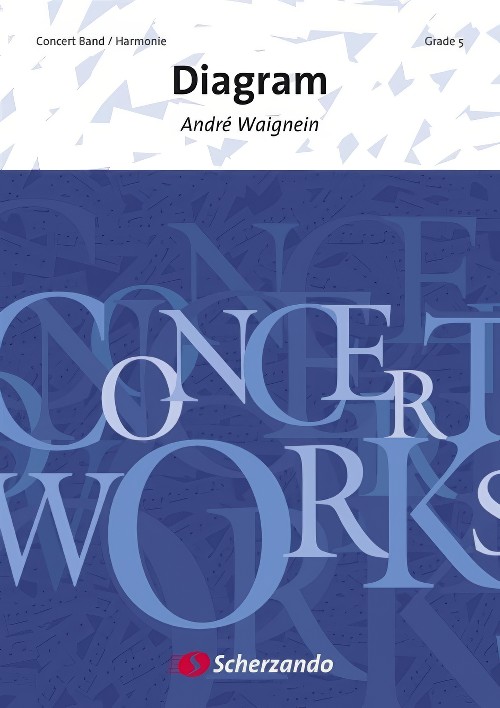Results
-
 £48.95
£48.95Korean Hill Song (Concert Band - Score and Parts) - Williams, Mark
The beautiful, well-known folk song "Arirang" is featured in this creative adaptation by Mark Williams. Colourful percussion writing and solos for alto saxophone and flute help to establish the tone of this very interesting arrangement. John Barnes Chance also used this folk song, named for Arirang Hill, near Seoul, in the concert band classic Variation on a Korean Folk Song. Take advantage of this great opportunity for younger musicians to experience this amazing melody! Duration: 2.30
Estimated dispatch 7-14 working days
-
 £139.99
£139.99Pacific Dreams (Concert Band - Score and Parts) - De Haan, Jacob
Pacific Dreams describes the experience of Miguel, a traveling composer from Spain who, feeling somewhat alienated from his homeland, is wandering through an area of Sydney known as The Rocks. At a small outdoor market in a typical street of this old colonial neighbourhood, he discovers a print of William DeShazos painting Pacific Dreams. Portrayed in the painting is the surf of one of the exotic islands in the Pacific. Next, with the impressive Sydney Harbour Bridge looming over the narrow streets of The Rocks, he envisions sultry Pacific beaches. Suddenly a theme he once composed about the lakes in Japan comes to him. Is it the Asian influences present in cosmopolitan Sydney that bring this theme to mind? Or perhaps the waters around Sydney, over which he could sail to Tahiti? He is uncertain. Could this same theme be used to create a new composition about his feelings for the metropolis Sydney? How then to work his Pacific Dreams into the mix? Miguel is certainly no fan of Hawaiian music. Maybe he could use the vocabularies of islands like Hawaii and Tahiti, their beautiful vowel combinations being sung ad libitum by a mixed choir.With these ideas and his newly purchased print of Pacific Dreams, he boards the Metro at Circular Quay. He has a final glimpse of the harbour and the Sydney Opera House as the train races into the ground. On to the hotel! To work! He must compose!Maestoso: Miguel is impressed as he gazes upon the Sydney Harbour Bridge. And yet, he wants to go away from this city. Away, to an exotic island in the Pacific.Steady Rock : In the Rocks, musicians are playing at a square. Miguel basks in the atmosphere but at the same time he is fantasising about Hawaii and Tahiti.Andante Lamentoso: In his hotel room, Miguel is feeling sad and lonely in this big city. He takes comfort in his Pacific Dreams.Allegro: Miguel boards the boat that takes him from Darling Harbour to Circular Quay. In his mind he is travelling on to Hawaii. Or is it home, where the bolero is playing? He is pulled back to reality by the skyline of Sydney.Duration: 9:15
Estimated dispatch 7-14 working days
-
 £169.99
£169.99Olympica (Concert Band - Score and Parts) - Van der Roost, Jan
This "Grand Overture" was commissioned by the "Nagano Community Band" - Japan- on occasion of its jubilee in 1992 and is dedicated to the band's conductor, Ikuo Inagaki. The work is based upon three main themes, each symbolising a certain theme. The first part is characterized by its bright themes played mainly by the brass, accompanied by the woodwinds and festive percussion. This part symbolizes the jubilee which is the origin of the composition. This is followed by a bouncing allegro, in which each register of the band displays brilliant techniques. Especially the woodwinds come to the fore! This movement depicts the industriousness and enthusiasm shown by the members of the "Nagano Community Band" in the carrying out of their hobby. A third, main theme, is choral-like in character and is displayed both in the (soft) brass as well as in the warm medium register of the reeds. Here, nature's beauty in and around the city of Nagano is musically celebrated. Following a "chamber-music episode" (featuring the flute, oboe, clarinet, alto-saxophone and horn) the initial allegro re-occurs, weaving its way towards a grandiose finale, in which the two previous themes are once again apparent. Due to its very colourful scoring and the enormous diversity of musical thoughts and ideas, this composition is a fascinating and memorable piece, worthy a jubilee overture!Duration: 10:15
Estimated dispatch 7-14 working days
-
 £179.99
£179.99Diagram (Concert Band - Score and Parts) - Waignein, Andre
The story of the origin of Diagram for Symphonic Band is a curious one. Andre Waignein was enjoying a meal together with his great friend Jean-Marie Vivier - representative director of l'Oreal Belgilux and the same man who made the performance of the famous Cantate aux Etoiles, with 750 performers possible. Jean Plaquet, an appreciated associate of both gentlemen was also present.As an acknowledgement, Andre Waignein wanted to dedicate a composition to the band where Mr. Vivier has been chairman for 20 years. In connection with this, Andre Waignein was supposed to receive some extra information about the 120 years old history of this band, which has always been led by a member of the Vivier family. In a flash this history was presented : using a diagram Mr. Vivier drew the power-lines of this more than 100 year old band.And of course, the title was found ! The only thing left to do, was for Andre Waignein to transform this diagram into music.Duration: 13:45
Estimated dispatch 7-14 working days
-
 £69.99
£69.99Barcelona '92 (Concert Band - Score and Parts) - Schelcke, Horst
The Olympic Games from the summer of 1992, officially known as the Games of the XXV Olympiad of the modern era, were held in the sunny Spanish city of Barcelona. This was the first time the Olympic Games had been held in Spain, and to celebrate this Horst Schelke composed this rousing concert march with a typically Spanish feel. Relive the excitement of this great event with this superb march.Duration: 2:30
Estimated dispatch 7-14 working days
-
 £68.00
£68.00As the Moon Whispers
Gorgeous! This expressive piece of work by Benjamin Yeo paints a musical picture of a young child sleeping soundly beside the window, listening to the whispering voice of the moon. Benjamin's careful and creative scoring makes this work a great tool to remind your players about the importance of good tone production, balance and phrasing; and at the same time, a manageable yet effective piece with interesting percussive elements to portray this beautiful night setting. This tune will definitely leave a deep and long-lasting impression to both your performers and audiences after your next concert. You certainly cannot miss this one!
Estimated dispatch 7-14 working days
-
 £149.99
£149.99Bridge Between Nations Wind Band Set (Score & Parts)
This work builds a musical bridge between the nations of the European Union. In this composition each country is represented by a fragment of its national anthem. The listener will continually be surprised by the creative way the national anthems are presented. The national anthems of the nations that have become part of the EU in 2004 have already been included in this piece. Because the fragments follow each other and complement each other in a logical way, this work does not sound like a regular medley but rather like a varied concert work with interesting elements of folklore. For most of the national anthems Jacob de Haan has chosen a minor key, which gives this work an extra emotional, sometimes melancholic overtone. 0:09:30
Estimated dispatch 7-14 working days
-
 £149.99
£149.99Columbus Wind Band Set (Score & Parts)
Christopher Columbus was born in Genoa in 1451. His father was a wool merchant. Originally he seemed destined to follow in his father's footsteps, and thus sailed the oceans to countries as far apart as Iceland and Guinea. In 1476 his ship was sunk during a battle off the coast of Portugal. Columbus saved his own life by swimming to shore. In 1484 he conceived the idea of sailing to the Indies via a westward sea route, but it was only in 1492 that he was able to realize this plan. On this first voyage he was in command of three ships: the flag-ship, called the Santa Maria, the Pinta, and the Ni?a. From Spain Columbus sailed via the Canary Islands to the Bahamas, which he sighted on October 12th 1492. Without being aware of it Columbus discovered the 'New World' - he thought he had landed in the eastern part of Asia. The motif from Dvo??k's 9th Symphony 'Aus der neuen Welt' forms a little counterfeit history at this point in the composition. After this first voyage Columbus was to undertake another three long voyages to America. These voyages were certainly not entirely devoid of misfortune. More than once he was faced with shipwreck, mutiny and the destruction of settlements he had founded. After Columbus had left for Spain from Rio Belen in 1503, he beached his ships on the coast of Jamaica. The crew were marooned there and it was only after a year that Columbus succeeded in saving his men and sailing back to Spain with them. In the music the misunderstanding about which continent Columbus discovered in his lifetime resounds, for does this part in the composition not contain Asiatic motifs? Poor Columbus! In 1506 the famous explorer died in Valladolid. 09:00
Estimated dispatch 7-14 working days
-
 £264.99
£264.99Panoptikum (Concert Band - Score and Parts)
Armin Schaer commissioned this work in his search for a new piece for the tuba. More specifically, he wanted a work that showed off the versatility of this splendid instrument, written in a musical style that is both fresh and modern, while not banishing the orchestra to a simple supporting role. Taking all these specifications into account, Thomas Doss created a work that allows stylistic leaps and is fun, exciting, romantic, and virtuosic, but does not lose sight of the thread that connects the opening measures to the very last.Armin Schaer describes his Panoptikum as follows:Panoptikum is a show of appreciation for my beautiful home and community at Lake Constance, an eventful life, the people that have enriched this life, and a fascinating instrument: the tuba. This work musically embodies the many different moods found around theBodensee - cheerfulness and melancholy, departures and longing, calm and agitation. The roles of the soloist and the orchestra were consciously crafted in a way that does not follow the usual conventions of the genre. The work should spark emotions, address broad segments of listeners, and persuade them of the tuba's ability to be a solo instrument as well as the richness symphonic wind ensembles have to offer. I hope this work enriches the lives of all the soloists and orchestras that cross its path, as well as everyone in the audience who gets to partake! 15:30
Estimated dispatch 7-14 working days
-
 £154.99
£154.99Piccola Suite Italiana (Concert Band - Score and Parts)
With this new suite for concert band Franco Cesarini draws on the rich repertoire of folk songs from the Friuli Venezia Giulia region of northern Italy. Between the 16th and 17th Century this rural region developed the 'furlana', a brilliant dance in 6/8 time. This catchy dance soon spread throughout Europe and became more cultivated. Fran?ois Couperin (1668-1733), Georg Philipp Telemann (1681-1767) and Johann Sebastian Bach (1685-1750) all composer of the 18th century composed 'furlane' and in the 20th Century Maurice Ravel used a 'furlana' dance his Tombeau de Couperin. Franco Cesarini follows this great tradition by using the 'furlana' as the basis for this major new concert work. 08:49
Estimated dispatch 7-14 working days
